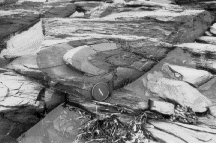An Introduction to Structural Geology and Tectonics
|
An Introduction to Structural Geology and Tectonics |
4. Deformation and Strain
 A
fold is a manifestation of distortion, in which originally horizontal beds
are now folded. This fold, and we will see many other examples, illustrate
the permanent shape changes that occur in many natural rocks. The study
of these distortions, which occur in response to forces acting on bodies,
is the subject of deformation. Recall, for example, the force of gravity
and its many expressions. It is easy pouring syrup on pancakes because
of the presence of gravity, but in the space shuttle it is quite difficult
to keep the syrup in place. The fact that you are able to read this text
sitting down is another convenient effect of gravity; in the space shuttle
you would be floating around (probably covered by syrup). As another example,
forces exerted by your body enable you to move around, but they do not
provide enough acceleration to leave the Earth's surface for any length
of time (because gravity pulls you back). Now let us consider a more controlled
experiment to analyze the response of materials to an applied force. We
can easily change the shape of a cube of clay or plasticine, by the action
of, say, your hands. Where forces affect the spatial geometry of a body
(syrup, you, plasticine òr rocks) we enter the realm of deformation.
Simply stated: deformation of a body occurs in response to forces . From
the examples given here you see that this response may have many faces.
In one case the body is merely displaced or rotated (e.g., getting up from
the chair and moving around the room). In other cases the body becomes
distorted (e.g., plasticine cube and syrup). In this chapter we will examine
such responses both qualitatively and quantitatively.
A
fold is a manifestation of distortion, in which originally horizontal beds
are now folded. This fold, and we will see many other examples, illustrate
the permanent shape changes that occur in many natural rocks. The study
of these distortions, which occur in response to forces acting on bodies,
is the subject of deformation. Recall, for example, the force of gravity
and its many expressions. It is easy pouring syrup on pancakes because
of the presence of gravity, but in the space shuttle it is quite difficult
to keep the syrup in place. The fact that you are able to read this text
sitting down is another convenient effect of gravity; in the space shuttle
you would be floating around (probably covered by syrup). As another example,
forces exerted by your body enable you to move around, but they do not
provide enough acceleration to leave the Earth's surface for any length
of time (because gravity pulls you back). Now let us consider a more controlled
experiment to analyze the response of materials to an applied force. We
can easily change the shape of a cube of clay or plasticine, by the action
of, say, your hands. Where forces affect the spatial geometry of a body
(syrup, you, plasticine òr rocks) we enter the realm of deformation.
Simply stated: deformation of a body occurs in response to forces . From
the examples given here you see that this response may have many faces.
In one case the body is merely displaced or rotated (e.g., getting up from
the chair and moving around the room). In other cases the body becomes
distorted (e.g., plasticine cube and syrup). In this chapter we will examine
such responses both qualitatively and quantitatively.